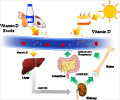
Recommendations from the CPG include:
- Screening for vitamin D deficiency in individuals at risk for deficiency;
- Measurement of vitamin D level by a reliable assay as the initial diagnostic test in patients at risk for deficiency; and
- Treatment with either vitaminD2 or vitamin D3 for deficient patients.
The CPG also features recommendations for dietary intake of vitamin D in patients at risk for vitamin D deficiency. These recommendations include:
- Infants and children ages 0-1 year require at least 400 IU/day (IU=25 ng) of vitamin D and children 1 year and older require at least 600 IU/day to maximize bone health. To raise the blood level of vitamin D consistently above 30 ng/ml may require at least 1,000 IU/day of vitamin D;
- Adults aged 19-50 years require at least 600 IU/day of vitamin D to maximize bone health and muscle function and at least 1,500-2,000 IU/day of vitamin D may be needed to maintain blood level of vitamin D above 30 ng/ml;
- Adults aged 50-70 years and adults older than 70 years require at least 600 IU/day and 800 IU/day respectively of vitamin D. At least 1,500-2,000 IU/day of vitamin D may be needed to maintain blood level of vitamin D above 30 ng/ml; and
- Pregnant and lactating women require at least 600 IU/day of vitamin D and at least 1,500 IU/day of vitamin D may be needed to maintain blood level of vitamin D above 30 ng/ml.
"At the present time, there is not sufficient evidence to recommend screening individuals who are not at risk for deficiency or to prescribe vitamin D to attain the non-calcemic benefit for cardiovascular protection," said Holick.
Advertisement













